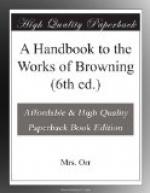“The Englishman in Italy.” ("Dramatic Romances.” Published as “England in Italy” in “Dramatic Romances and Lyrics.” 1845.) And even here we receive the picture with a lyric and dramatic colouring, which makes it much less one of facts than of associations. It is also to be remarked that, in these poems, the associations are of two opposite kinds, and Mr. Browning is in equal sympathy with both. He feels English scenery as an Englishman does: Italian, as an Italian might be supposed to, feel it.
“DE GUSTIBUS—” illustrates the difference of tastes by the respective attractions of these two kinds of scenery, and of the ideas and images connected with them. Some one is apostrophizing a friend, whose ghost he is convinced will be found haunting an English lane, with its adjoining corn-field and hazel coppice: where in the early summer the blackbird sings, and the bean-flower scents the air. And he declares at the same time that Italy is the land of his own love, whether his home there be a castle in the Apennine, or some house on its southern shore; among “wind-grieved” heights, or on the edge of an opaque blue sea: amidst a drought and stillness in which the very cicala dies, and the cypress seems to rust; and scorpions drop and crawl from the peeling walls ... and where “a bare-footed girl tumbles green melons on to the ground before you, as she gives news of the last attack on the Bourbon king.”
“HOME-THOUGHTS, FROM ABROAD” is a longing reminiscence of an English April and May, with their young leaves and their blossoms, their sunshine and their dew, their song of the chaffinch and their rapturous music of the thrush. Appreciation is heightened by contrast; and the buttercup—England’s gift to her little children—is pronounced far brighter than the “gaudy melon-flower” which the exiled Englishman has at this moment before him.
“THE ENGLISHMAN IN ITALY” is a vivid picture of Italian peasant-life on the plain of Sorrento: the occasion being an outbreak of the well-known hot wind—the “scirocco”—which, in this case, has brought with it a storm of rain. A little frightened peasant girl has taken refuge by the side of the Englishman, who is apparently lodging in her mother’s cottage. And he is diverting her attention by describing his impressions of the last twenty-four hours: how everything looked before the rain; how he knew while yet in bed that the rain had come, by the rattling down of the quail-nets,[93] which were to be tugged into shelter, while girls ran on to the housetops to fetch the drying figs; how the black churning waters forbade the fishermen to go to sea (what strange creatures they bring home when they do go, and how the brown naked children, who look like so many shrimps, cling screaming about them at the sight); how all hands are now employed at the wine-making, and her brother is at this moment dancing bare-legged in a vat half as high as the house; how the bigger girls bring baskets of grapes, with




